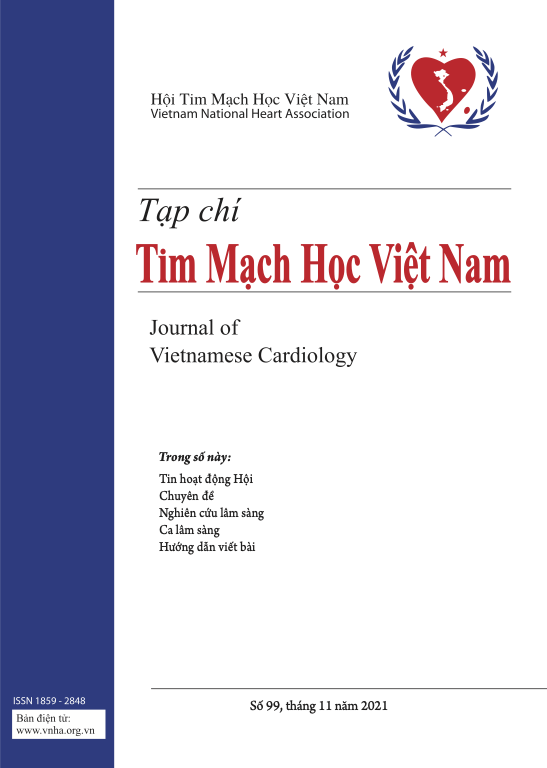Hội chứng Brugada: Cập nhật chẩn đoán, phân tầng nguy cơ và điều trị
DOI:
https://doi.org/10.58354/jvc.107S(1).2024.777Tóm tắt
Hội chứng Brugada, được mô tả lần đầu vào năm 1992, là bệnh lý di truyền trội trên nhiễm sắc thể thường, biểu hiện bởi điện tâm đồ đặc trưng và nguy cơ rối loạn nhịp thất nguy hiểm dẫn đến đột tử. Phần lớn người bệnh Brugada không có biểu hiện lâm sàng, thay vào đó, bệnh được tình cờ phát hiện thông qua các bất thường điện tâm đồ qua khám sức khỏe định kỳ hoặc qua sàng lọc thân nhân của những người bệnh Brugada. Đối với những người bệnh có biểu hiện triệu chứng, bệnh cảnh lâm sàng cũng khá đa dạng với những triệu chứng không đặc hiệu, bao gồm ngất (30%), khó thở về đêm (12%), cơn nhanh thất/rung thất (6%), và đột tử SCD (6%). Trong đó biểu hiện đột tử có thể là biểu hiện đầu tiên của bệnh mà không có bất kì một dấu hiệu dự báo nào trước đó. Cũng giống như các bệnh lý rối loạn nhịp di truyền khác, hội chứng Brugada có sự biến thiên rất lớn về kiểu hình lâm sàng giữa từng cá thể người bệnh. Người bệnh có điện tâm đồ dạng Brugada type 1 có thể không xuất hiện biến cố rối loạn nhịp trong suốt cuộc đời, tuy nhiên, cũng có một tỉ lệ nhất định xảy ra đột tử, hoặc các biến cố rối loạn nhịp khác. Sự biến thiên về kiểu hình lâm sàng này cho thấy, cơ chế bệnh sinh của hội chứng Brugada là tương đối phức tạp và hiện vẫn còn nhiều tranh cãi. Cho tới thời điểm hiện tại, với những hiểu biết ngày càng sâu hơn về cơ chế điện học và di truyền học, cũng như những bằng chứng lâm sàng mới được báo cáo, đã có nhiều thay đổi về chẩn đoán cũng như phân tầng nguy cơ và điều trị đối với người bệnh hội chứng Brugada.
Tài liệu tham khảo
Priori SG, Blomström-Lundqvist C, Mazzanti A, et al. 2015 ESC Guidelines for the management of patients with ventricular arrhythmias and the prevention of sudden cardiac death: The Task Force for the Management of Patients with Ventricular Arrhythmias and the Prevention of Sudden Cardiac Death of the European Society of Cardiology (ESC)Endorsed by: Association for European Paediatric and Congenital Cardiology (AEPC). Eur Heart J. 2015;36(41):2793-2867. doi:10.1093/eurheartj/ehv316
![]()
Zeppenfeld K, Tfelt-Hansen J, de Riva M, et al. 2022 ESC Guidelines for the management of patients with ventricular arrhythmias and the prevention of sudden cardiac death. Eur Heart J. 2022;43(40):3997-4126. doi:10.1093/eurheartj/ehac262
![]()
Fernandes GC, Fernandes A, Cardoso R, et al. Ablation strategies for the management of symptomatic Brugada syndrome: A systematic review. Heart Rhythm. 2018;15(8):1140-1147. doi:10.1016/j.hrthm.2018.03.019
![]()
Conte G, Sieira J, Ciconte G, et al. Implantable cardioverter-defibrillator therapy in Brugada syndrome: a 20-year single-center experience. J Am Coll Cardiol. 2015;65(9):879-888. doi:10.1016/j.jacc.2014.12.031
![]()
Rattanawong P, Mattanapojanat N, Mead-Harvey C, et al. Predicting arrhythmic event score in Brugada syndrome: Worldwide pooled analysis with internal and external validation. Heart Rhythm. 2023;20(10):1358-1367. doi:10.1016/j.hrthm.2023.06.013
![]()
Honarbakhsh S, Providencia R, Garcia-Hernandez J, et al. A Primary Prevention Clinical Risk Score Model for Patients With Brugada Syndrome (BRUGADA-RISK). JACC Clin Electrophysiol. 2021;7(2):210-222. doi:10.1016/j.jacep.2020.08.032
![]()
Kawada S, Morita H, Antzelevitch C, et al. Shanghai Score System for Diagnosis of Brugada Syndrome: Validation of the Score System and System and Reclassification of the Patients. JACC Clin Electrophysiol. 2018;4(6):724-730. doi:10.1016/j.jacep.2018.02.009
![]()
Yamagata K, Horie M, Aiba T, et al. Genotype-Phenotype Correlation of SCN5A Mutation for the Clinical and Electrocardiographic Characteristics of Probands With Brugada Syndrome: A Japanese Multicenter Registry. Circulation. 2017;135(23):2255-2270. doi:10.1161/CIRCULATIONAHA.117.027983
![]()
Ishikawa T, Kimoto H, Mishima H, et al. Functionally validated SCN5A variants allow interpretation of pathogenicity and prediction of lethal events in Brugada syndrome. Eur Heart J. 2021;42(29):2854-2863. doi:10.1093/eurheartj/ehab254
![]()
Antzelevitch C, Yan GX, Ackerman MJ, et al. J-Wave syndromes expert consensus conference report: Emerging concepts and gaps in knowledge. Heart Rhythm. 2016;13(10):e295-324. doi:10.1016/j.hrthm.2016.05.024
![]()
Probst V, Veltmann C, Eckardt L, et al. Long-Term Prognosis of Patients Diagnosed With Brugada Syndrome: Results From the FINGER Brugada Syndrome Registry. Circulation.2010;121(5):635-643.doi:10.1161/ CirculationAHA.109.887026
![]()








